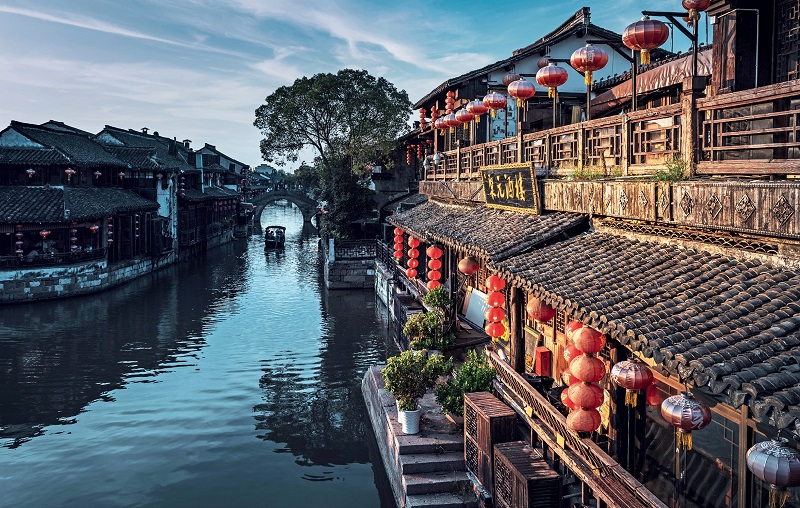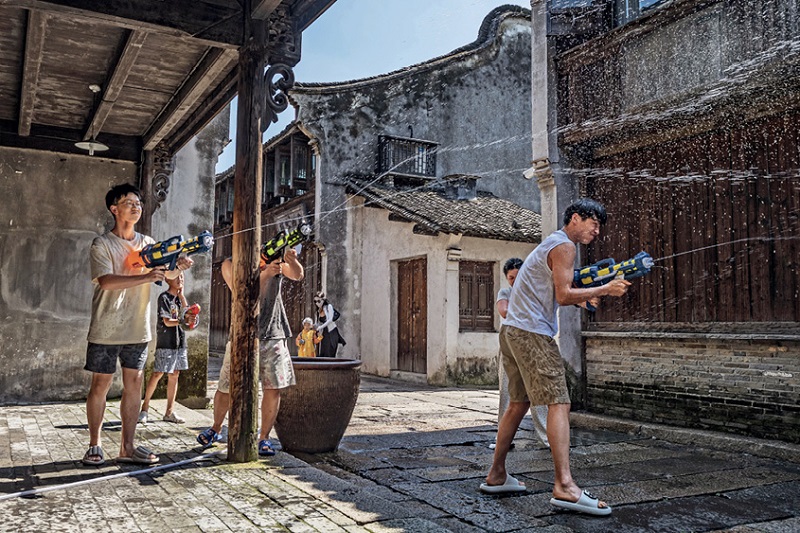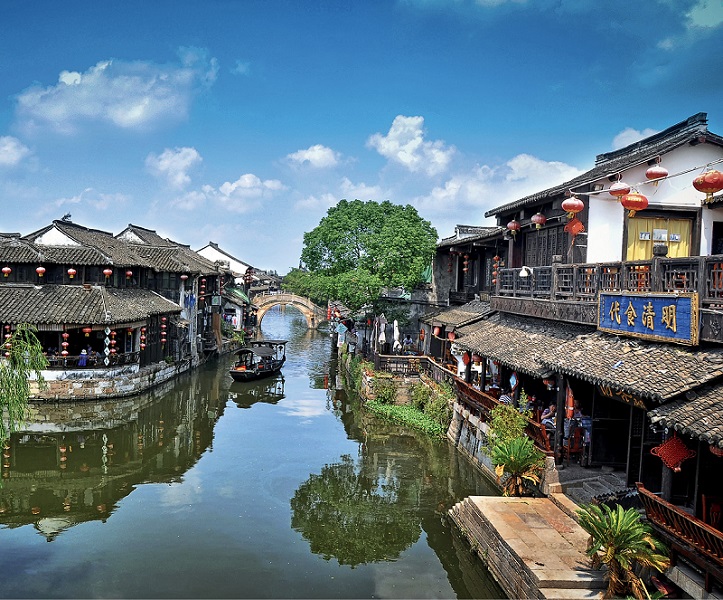
The Yanyu Corridor is one of Xitang’s famous landmarks.
Wuzhen and Xitang, two old towns in Zhejiang Province in east China, are historically known as places of singular serenity and sublime beauty. Today, they are top tourist destinations because of their well-preserved landscapes, gleaming water bodies, and bracing water town air.

The Water Splashing Festival in Wuzhen on July 4, 2024.
Wuzhen
Wuzhen’s history goes back to 872. It is part of the Grand Canal network running from China’s north to south, constructed in stages from the fifth century BC and today a UNESCO World Heritage Site. The waterway was a main route of vital trade and Wuzhen enjoyed prosperity throughout history by virtue of the lucrative canal.
It also has a long history of indigo dyeing, going back millennia. Two old dye houses remain open, where visitors can learn the basics of indigo dyeing as well as dabble in actual dyeing themselves. In the yard of the dye houses, pieces of dyed fabric sway in the wind on rows of poles. There are also stores selling bamboo item, silk reeling workshops, shoe making shops, and other traditional handicraft sites, giving a glimpse of the cultural tapestry of Wuzhen life. This rich legacy has made it one of the most-visited ancient scenic towns in China.
Like in other water towns, traveling by water is the most common means of transport in Wuzhen. The old rowing boat has been transformed into fun tourism transport. Boating is a way to explore the landscape, while listening to the oarsmen talking about the history about the town. Boats are readily available, so just hop on one.
To understand and experience the daily lives of local residents, visiting a morning tea house and the water market is a must. Morning tea is an indispensable part of local people’s daily rituals and Wuzhen residents usually start their day sipping tea in tea houses early in the morning. After finishing their tea and chatting with friends, acquaintances and even strangers, they row to the morning market to sell homegrown vegetables and poultry products. All products are sold on boats, which is why the market is known as the water market.

An aerial view of tourists flocking to the thousand-year-old ancient town of Wuzhen during the long Labor Day holiday, May 3, 2024.
During the day, you can see a long line in front of the Xuchang soybean paste yard with people queuing up to buy its soybean pastes. Xuchang is a time-honored brand. It can be traced back to 1859, and is the first of its kind in Wuzhen. The soybean paste is localy renowned for its salty, sweet and spicy flavors, and used to be made for the imperial family in the past. At the front of the yard is the shop where people can buy their desired sauces and at the back, a 360-square-meter yard houses around 200 vessels of soybean pastes.
Zhaoming Academy, one of the most-visited places in Wuzhen, is named after its founder, Crown Prince Xiao Tong (501-531) of the Liang Dynasty (502-557), who compiled a literary compendium, Wen Xuan (Selections of Refined Literature). Today, a stone archway dedicated to him stands at the entrance of this academy while the main building is a modern library and the porch outside the library a calligraphy room with basic writing tools.
Eminent novelist Shen Dehong (1896-1981), known by his pen name Mao Dun, was born and grew up in Wuzhen. His old house is now under state protection as a cultural relic. The 500-square-meter residence was built in the mid-19th century and offers a home tour, giving visitors a look into the novelist’s early life.
Painter and poet Muxin (1927-2011) was also born and raised in Wuzhen and spent his last years here. A museum built in his honor displays details about his life as well as his literature and art legacies.
Wuzhen holds various events rooted in traditional festivals. During the Spring Festival, there are performances on land and water and lantern shows. During the Dragon Boat Festival, there are dragon boats festooned with lanterns and zongzi market selling various kinds of zongzi – glutinous rice dumplings with a sweet filling.

An ancient bridge in Xitang.
Xitang
Xitang is another millennia-old town famed for its bridges, alleyways and porches. The water town has over 100 bridges, with the earliest one dating back to the Song Dynasty (960-1279). Most of the well-preserved historical bridges are single- or three-arched ones made of wood and stone. The Huanxiu Bridge, situated at a high point, is a good spot to admire the scenery of the town. The Laifeng Bridge boasts a very unique design. This 10-meter-wide covered bridge is divided by a wall in the middle. One side has steps, while the other has a slope, facilitating pedestrians’ passage.
Most of the streets in Xitang are covered, providing shelter for vendors and pedestrians from rain and sun. The Yanyu Corridor, literally meaning the Misty Rain Corridor, stretching over 2,000 meters, is one of Xitang’s most famous landmarks. The corridors have wooden frames and tiled roofs, and are generally 2 to 2.5 meters wide. There are long benches with backrests for people to rest.
Xitang has a network of crisscrossing alleys. The Shipi Alley is the longest and narrowest, with an average width of only one meter, while its narrowest part is just 0.8 meters. This unique feature makes it a popular attraction.
Xitang has a profusion of buildings from the Ming and Qing dynasties (1368-1912). Among them, the Zuiyuan Garden, West Garden, Wang’s Residence, and Ni’s Residence are open to tourists.
The Zuiyuan Garden, built in the Ming Dynasty (1368-1644), used to be the courtyard of a local family called the Wangs. It has a miniature stone bridge, the Zuiyan Bridge, which can be crossed by only one person at a time.

Xitang’s traditional landscapes have been preserved with care.
Wang’s Residence includes a rear garden, typical of Ming and Qing Dynasty residential complexes. The West Garden, built during the Ming Dynasty, was a well-known picturesque place with a fascinating combination of pavilions, gazebos, ponds, rockery and other landscape elements. Ni’s Residence, built during the Republic of China (1912-1949), was the residence of the Ni family, known for their literary background. It once hosted a poets’ society.
The most important folk festival in Xitang takes place on the third day of the fourth month in the traditional Chinese calendar each year. Legend has it that an official surnamed Jin was responsible for transporting grain. Once while passing the town, he saw the local people suffering from a severe locust infestation and distributed the grain among the people without waiting for the permission of his seniors. He was put to death for violating the law but when the government came to know the whole story, it honored him with a posthumous title. The local people built a shrine in his name and every year, tributes are paid there to this virtuous official.
At the Button Museum, visitors can learn about Xitang's button industry. Xitang is known as a button powerhouse in China, as around 50 percent of the buttons sold in China are made here. The museum houses a collection of over 1,000 buttons from the Han Dynasty (202 BC-AD220) to the modern era, and there are craftsmen on site demonstrating how shell buttons, a Xitang specialty, are made.
Many residents of Wuzhen and Xitang have renovated their old houses into guesthouses for tourists, and some visitors keep on returning to the magic towns to experience their slow-paced life and unwind. Some tourists become friends for life with local residents.